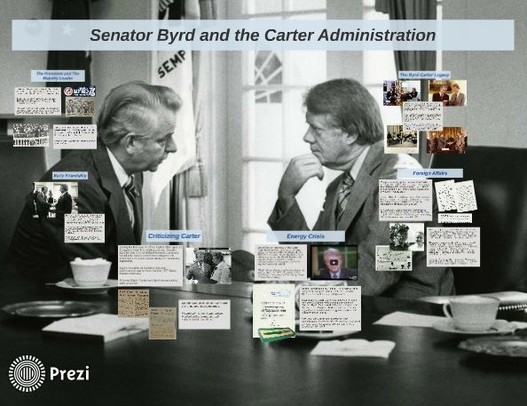|
By Malorie Matos This week, we’re launching a new virtual exhibit on the Byrd CLS website entitled Senator Byrd and the Carter Administration, spanning the presidency of Jimmy Carter. I created this exhibit over the course of my last semester at Shepherd University in conjunction with my final capstone paper on the topic of archives and online public outreach. This week, we’re launching a new virtual exhibit on the Byrd CLS website entitled Senator Byrd and the Carter Administration, spanning the presidency of Jimmy Carter. I created this exhibit over the course of my last semester at Shepherd University in conjunction with my final capstone paper on the topic of archives and online public outreach.
My initial project goals were to expand online public outreach at the archive, to utilize web tools as a means of promoting user-interaction, and to draw in new users by promoting our current archival collections. I decided that an online exhibit would be the best way to reach these goals given our collection scope and outreach resources. As with any exhibit, virtual or physical, it is best to choose a focused topic that will be unique to the host archive. Last summer I worked on a blog series covering the relationships between Senator Byrd and the Presidents. I realized that one short post about Jimmy Carter was not enough to showcase how much content we had on that particular administration. It was at this time that I was in the process of working on my public history capstone, so this exhibit helped to illustrate my research. I spoke with Jody Brumage, the archivist of the Byrd Center, who created an online exhibit for the archives, Senator Byrd’s Life and Career: An Exhibit using the presentation software Prezi. After researching different styles of online exhibits currently in use by other archives and various cultural institutions, I decided on the model suggested by Jody. His exhibit became the primary example for my own because it was the best fit for our budget and would appear more cohesive on the website. Although Prezi is not necessarily intended for virtual exhibitions of this type, the software actually lends itself very well to the content. Prezi allows users to move freely through the online exhibit much like they would in a physical exhibit. They can go in sequential order or they can skip around from one “display case” to another. One of the many benefits using Prezi for an exhibit is that it gives users the capability to zoom in on certain documents or objects and get closer than they might even in a physical exhibit. The result is a fully interactive and visually stimulating virtual exhibit experience. After deciding on the software, it was time to begin researching and gathering content. Since the research was for an online exhibit, I focused on finding the most visually interesting records from our collection. To keep things simple, I decided to break the exhibit down into six small sections that best illustrated the narrative surrounding the Byrd/Carter relationship. Through exhibits like this one, I’d like to promote more user interaction with our archive and to boost our web presence. By showing the public the kind of content we have in our collections and how we use it, I hope to pique the interest of new and old users alike. Comments are closed.
|
Welcome to the Byrd Center Blog! We share content here including research from our archival collections, articles from our director, and information on upcoming events.
Categories
All
Archives
July 2023
|
Our Mission: |
The Byrd Center advances representative democracy by promoting a better understanding of the United States Congress and the Constitution through programs and research that engage citizens.
|
Copyright © Robert C. Byrd Center for Congressional History and Education
|


 RSS Feed
RSS Feed
